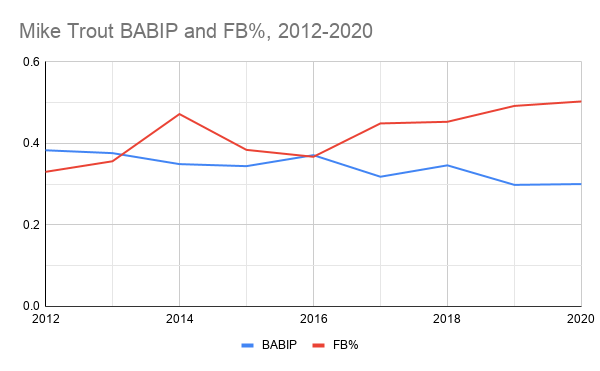After never posting a batting average on balls in play below .344 in any full season in his career, Mike Trout saw that number dip to a much more pedestrian .318 in 2017. After a brief rebound in 2018, it has remained much closer to the league average BABIP in the past two seasons (.298 in 2019 and .292 in 2020, respectively).
For years, BABIP has been the first touchstone for professional and amateur baseball analysts alike when it comes to player performance and the likelihood of sustainability. A 29-year old hits .350 in the first month of the season but his BABIP is .450? There’s no way that’ll last. The all-star right fielder is hitting .210 in May? BABIP of .200, he’ll turn it around.
My editor feels this introduction is getting off the rails? Hey, I’m having a bad BABIP start.
It’s a bit of surprise to see Trout, the patron saint of offseason baseball analytics pieces, to have a steadily declining BABIP that’s declining year over year, inching toward league average. There’s something to suggest that he could be getting on base even more than he already is, and possibly Trout is hitting into bad luck. He has made 56 outs on balls in play that had an expected wOBA greater than .900 since 2015, tied for 5th in baseball in that timeframe with J.D. Martinez, and one spot behind Nelson Cruz. That list of batted ball events is lousy with “sharp flyouts” to outfielders, with only eight of them recording exit velocities below 100 mph and only a quarter with launch angles under 25 degrees.
One might guess that Trout is not beating out as many throws on grounders to reach, but that seems unlikely for a player that has never been worse than the 94th percentile of sprint speed during his time in the majors. And, in fact, Trout is still reaching base on more than 10% of the balls he hits on the ground, well above the league average this year of 7%.
Not to mention, Trout still absolutely crushes the ball. In 2020, he still managed to be in the top 1% of all hitters in terms of exit velocity off the bat. So, he isn’t experiencing much of a decline in speed or how hard he hits the ball. But there is one trend in his batted balls that has inversely correlated with his BABIP.

In 2017, when Trout’s BABIP began to decline sharply, it was accompanied by a huge increase in his rate of fly balls. That trend has continued pretty much unabated for the past four seasons. Trout is hitting more and more balls in the air, and, you’re not going to believe this, but Trout is doing something on the baseball field that’s causing him to be a bit of an outlier.
This year he actually crested the 50% fly ball mark. Of course, the season was short and we have no way of knowing whether he would have exceeded 50% in a full slate of games, but it’s not outlandish to consider, given that his fly ball rate has increased each year for the past four years and in 2019 he was at 49% in a near-full season of plate appearances.
That’s unusual because since Trout entered the league, a player has exceeded the 50% mark in fly balls in a season only 12 times. Joey Gallo and Rhys Hoskins have each done it twice, and the rest of the list is primarily populated with slugging homer-or-bust types (e.g., Chris Carter, Brandon Moss). Those kind of fly ball-happy extremes typically aren’t exactly prevalent among the most valuable hitters in the game, but that’s analysis that applies only to mortals.
Trout is hitting the ball in the air as much as the most extreme fly ball hitters, which explains his lower-than-expected BABIP. But his ability to hit the ball hard and beat out infield hits along with maintaining his above-average line drive rate offsets that BABIP from tanking his on-base percentage or batting average. In fact, among those players who have hit more than half their balls in the air in a season, only noted fly ball revolutionary José Ramírez’s 2020 comes close to Trout’s .281 average and .390 OBP.
In Trout, you have a Gallo-type slugger that also is one of the fastest players in the game and also strikes out less than league average. His batting profile is like God turned up the sliders all the way on “MLB The Show.” Trout’s BABIP falls victim to hard-hit balls that seem sure to be the “right” swing in that they should fly out of the park but for whatever reason get hung up in the air or are hit to deep parts of the western ballparks. To wit:
https://gfycat.com/hiddenimpartialemu
And:
https://gfycat.com/sadjubilantbeardeddragon
One has to wonder when Trout’s extreme fly ball rate will plateau after so many years of steady incremental increases. It’s yet another fallback plan to be productive when (or if?) his skills decline as he ages. Time remains undefeated, however, and at the point that Trout’s speed is no longer among the top in baseball, he’ll have to once again adjust his approach to maintain his elite on-base skills.
Alternatively, it’s fascinating to consider that we haven’t even seen the most extreme of Trout’s fly balls, and he could continue to show us something nobody has done (the highest all-time single season fly ball rate was 2006 Frank Thomas, who slashed .270/.381/.545 with 39 homers with a .274 BABIP). Before that time though, his BABIP serves as a reminder that luck hardly needs to be bothered with when you’re Mike Trout.
Featured Image by Jacob Roy (@jmrgraphics3 on IG)

